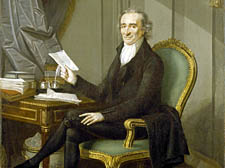| |

A 1791 portrait of Thomas Paine by Laurant Dabos from the Collection of the National Portrait Gallery |
Blunder denied Paine right to a statue
60 years on, historian discovers letter that reveals research error led to snub for revolutionary
PLANS to erect a statue of one of the founding fathers of America in Fitzroy Square were scrapped because the authorities did not realise he lived there.
In 1949 – more than 200 years after Thomas Paine’s death – the London Council General Purposes Committee received a request from the Thomas Paine Memorial Committee in New York, asking for a statue in the famous square to honour the English-born revolutionary.
In a bizarre blunder, it was ruled out because authorities failed to realise that Paine lived with his lifelong friend, the poet Clio Rickman, around the corner from the square in Upper Marylebone Place.
Born in 1737, Paine’s radical ideas can lay claim to be the driving force behind the American independence movement and the French revolution. His acolytes include George Washington, Abraham Lincoln, Bertrand Russell and most recently President Barack Obama, who used Paine’s words in his inaugural address.
The slapdash research overlooked evidence from a government spy contained in a seminal history book of the time that confirmed Paine’s residence there. He had come under surveillance for what the government believed to be seditious ideas contained in his magnum opus The Rights of Man.
If the researcher, a Miss Darlington, had read PA Brown’s French Revolution in English History, Fitzroy Square could have joined Thetford in Norfolk in displaying a statue of the man recently voted No34 in a list of greatest Britons.
The revelation emerged more than 50 years after the bungle, when a Fitzrovia-based archivist and historian chanced upon the letter blocking the request in a dusty box in the London Metropolitan Archives.
Ironically, Jess Owen, a Paine enthusiast, said his hero would not have wanted a statue and that and any present-day campaign to mount a statue would be pointless.
Mr Owen said: “I think maybe he should have a plaque, but as for a statue I don’t think he would have given a tuppence about it. He was an unassuming man and stood very much opposed to idols. Plus I think his true legacy are his books and that is what we should celebrate. If we did have a statue various groups would try and claim him for their own.”
Paine was born in Norfolk and emigrated to the American colonies in 1774. While there he wrote a number of influential pamphlets supporting independence and revolution including Common Sense (1776) and The American Crisis (1776-1783).
He later moved to Paris, where his advocacy of Enlightenment ideas made him a prominent figure in the French Revolution. His contempt for organised religion and the Christian doctrine explored in The Age of Reason eventually made him enemies and he was put in prison in 1793. He moved back to America, where he died an outcast in 1809.
Barbara Jacobson, secretary of the Thomas Paine Society in London, said: “It is very strange that there isn’t a statue of Paine. We would love to see a statue in Fitzroy Square.” |
 |
|
 |
| |
| |